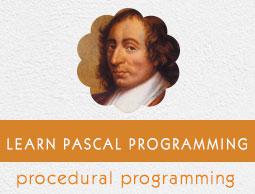Pascal - Units
A Pascal program can consist of modules called units. A unit might consist of some code blocks, which in turn are made up of variables and type declarations, statements, procedures, etc. There are many built-in units in Pascal and Pascal allows programmers to define and write their own units to be used later in various programs.
Using Built-in Units
Both the built-in units and user-defined units are included in a program by the uses clause. We have already used the variants unit in Pascal - Variants tutorial. This tutorial explains creating and including user-defined units. However, let us first see how to include a built-in unit crt in your program −
program myprog;
uses crt;
The following example illustrates using the crt unit −
Program Calculate_Area (input, output);
uses crt;
var
a, b, c, s, area: real;
begin
textbackground(white); (* gives a white background *)
clrscr; (*clears the screen *)
textcolor(green); (* text color is green *)
gotoxy(30, 4); (* takes the pointer to the 4th line and 30th column)
writeln('This program calculates area of a triangle:');
writeln('Area = area = sqrt(s(s-a)(s-b)(s-c))');
writeln('S stands for semi-perimeter');
writeln('a, b, c are sides of the triangle');
writeln('Press any key when you are ready');
readkey;
clrscr;
gotoxy(20,3);
write('Enter a: ');
readln(a);
gotoxy(20,5);
write('Enter b:');
readln(b);
gotoxy(20, 7);
write('Enter c: ');
readln(c);
s := (a + b + c)/2.0;
area := sqrt(s * (s - a)*(s-b)*(s-c));
gotoxy(20, 9);
writeln('Area: ',area:10:3);
readkey;
end.
It is the same program we used right at the beginning of the Pascal tutorial, compile and run it to find the effects of the change.
Creating and Using a Pascal Unit
To create a unit, you need to write the modules or subprograms you want to store in it and save it in a file with .pas extension. The first line of this file should start with the keyword unit followed by the name of the unit. For example −
unit calculateArea;
Following are three important steps in creating a Pascal unit −
The name of the file and the name of the unit should be exactly same. So, our unit calculateArea will be saved in a file named calculateArea.pas.
The next line should consist of a single keyword interface. After this line, you will write the declarations for all the functions and procedures that will come in this unit.
Right after the function declarations, write the word implementation, which is again a keyword. After the line containing the keyword implementation, provide definition of all the subprograms.
The following program creates the unit named calculateArea −
unit CalculateArea;
interface
function RectangleArea( length, width: real): real;
function CircleArea(radius: real) : real;
function TriangleArea( side1, side2, side3: real): real;
implementation
function RectangleArea( length, width: real): real;
begin
RectangleArea := length * width;
end;
function CircleArea(radius: real) : real;
const
PI = 3.14159;
begin
CircleArea := PI * radius * radius;
end;
function TriangleArea( side1, side2, side3: real): real;
var
s, area: real;
begin
s := (side1 + side2 + side3)/2.0;
area := sqrt(s * (s - side1)*(s-side2)*(s-side3));
TriangleArea := area;
end;
end.
Next, let us write a simple program that would use the unit we defined above −
program AreaCalculation;
uses CalculateArea,crt;
var
l, w, r, a, b, c, area: real;
begin
clrscr;
l := 5.4;
w := 4.7;
area := RectangleArea(l, w);
writeln('Area of Rectangle 5.4 x 4.7 is: ', area:7:3);
r:= 7.0;
area:= CircleArea(r);
writeln('Area of Circle with radius 7.0 is: ', area:7:3);
a := 3.0;
b:= 4.0;
c:= 5.0;
area:= TriangleArea(a, b, c);
writeln('Area of Triangle 3.0 by 4.0 by 5.0 is: ', area:7:3);
end.
When the above code is compiled and executed, it produces the following result −
Area of Rectangle 5.4 x 4.7 is: 25.380
Area of Circle with radius 7.0 is: 153.938
Area of Triangle 3.0 by 4.0 by 5.0 is: 6.000


